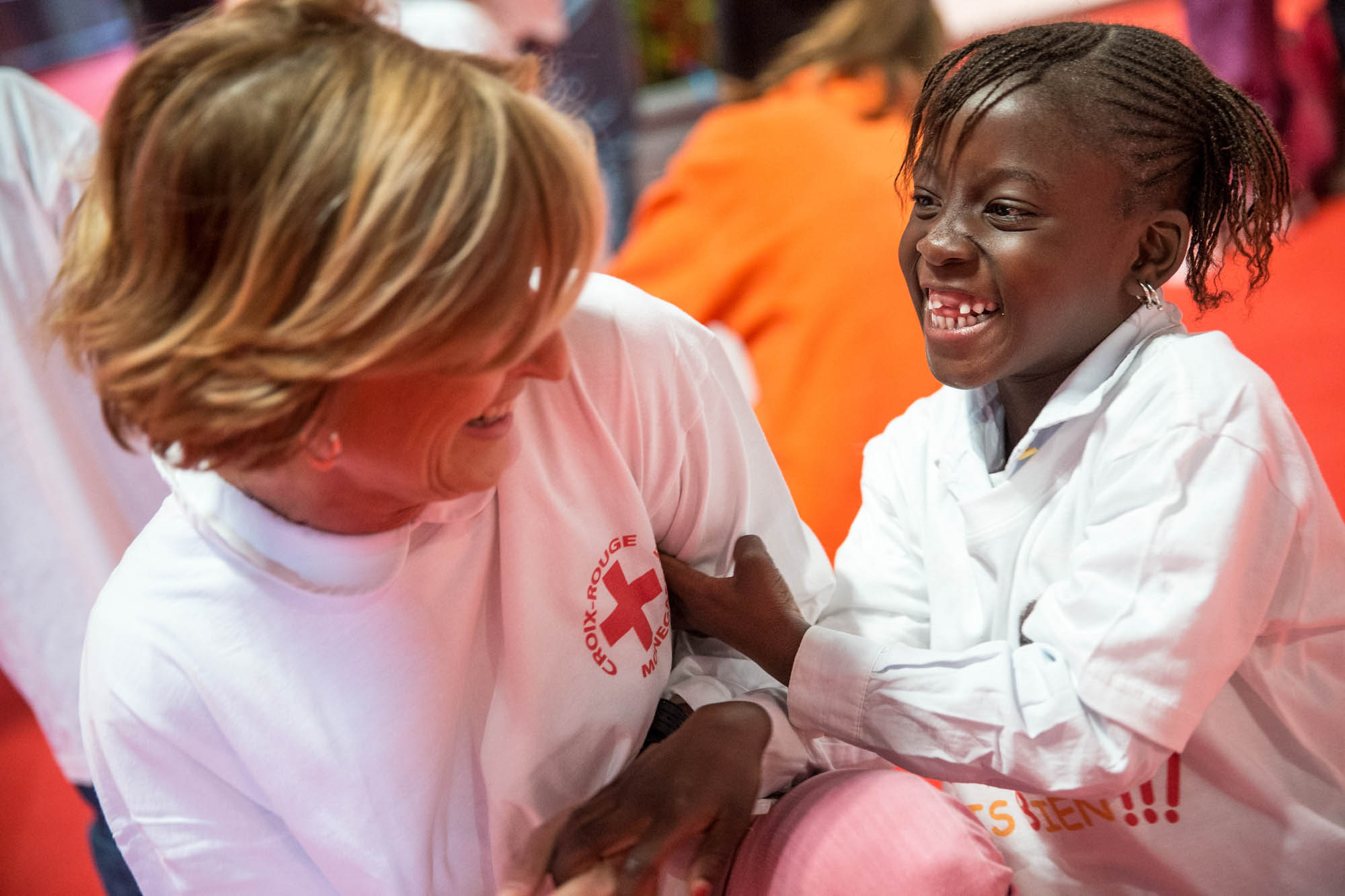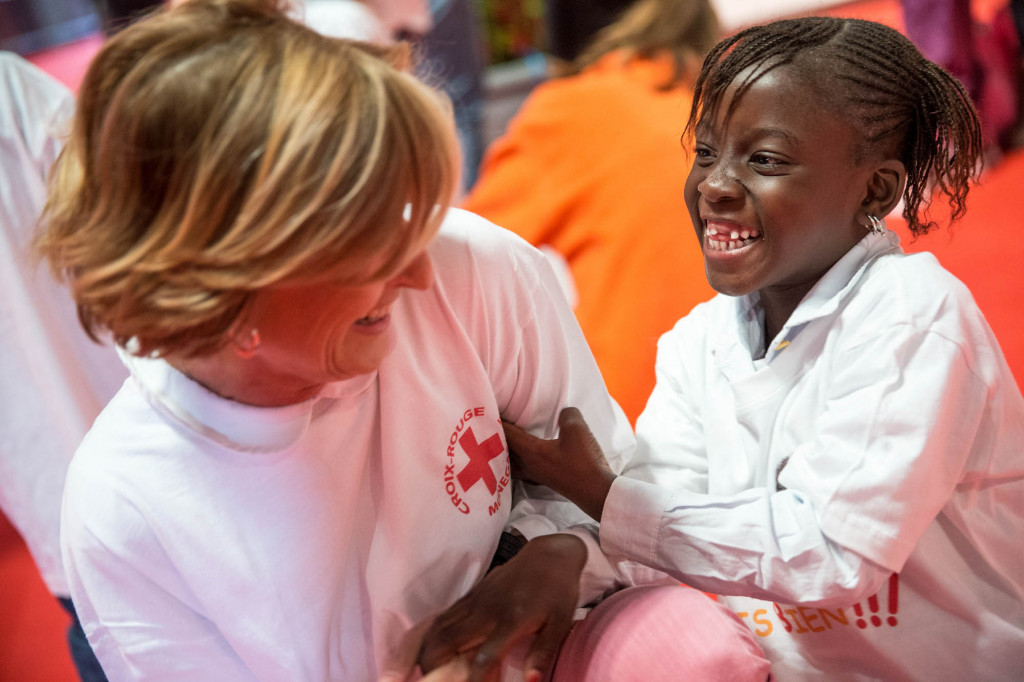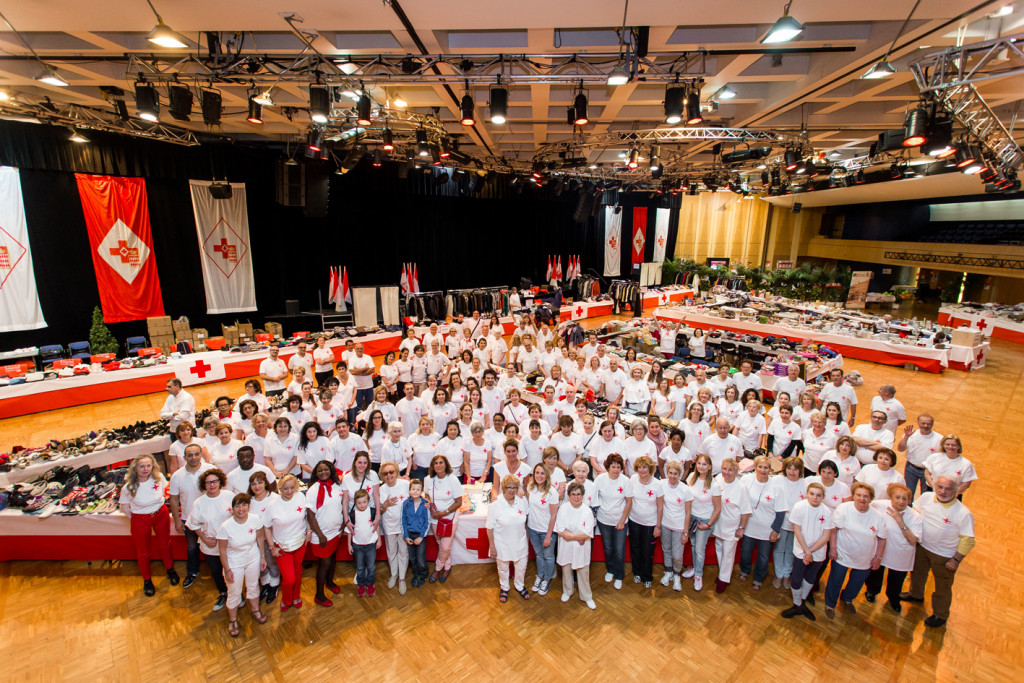ML: The Monaco Red Cross was created in 1948. How has the organisation evolved since then?
NG: The Monaco Red Cross was created on March 3, 1948 by Prince Louis II. In 1949, Prince Rainier III took over the Chairmanship until 1958, when he handed over this responsibility to his wife, Princess Grace of Monaco, who successfully developed the National Society while pursuing the actions undertaken by her predecessors. Since 1982, HSH Prince Albert took over from his mother as Chair of the Monegasque Red Cross, and has really been committed while undertaking all activities, both locally and internationally.
The Monegasque Red Cross (MRC) is presided over by Prince Albert and is assisted by a Board of Directors of 15 members appointed for three years by Sovereign Ordinance. Between two meetings of the Board of Directors, it’s the more restricted body, the Executive Committee, which ensures the proper functioning of the company.
In addition to the President, it includes the Vice-President, Mr Philippe Narmino, the Secretary General, Mr Frédéric Platini, the Treasurer General, Mrs Bettina Ragazzoni, and the Councilor, Dr Michel-Yves Mourou.
The National Society of the Red Cross of Monaco is constituted on the basis of the Geneva Convention of August 12, 1949 to which the Principality of Monaco belongs, and of the seven Fundamental Principles of the Red Cross adopted unanimously by the International Red Cross Conference in Vienna in October 1965: Humanity, Impartiality, Neutrality, Independence, Voluntary nature, Unity and Universality.
Since 1948, the MRC has been working with the most vulnerable. Through its role as an auxiliary of the public authorities, it helps those with a link – nationality, residence, work, schooling – with the Principality.
In recent years an economic crisis has had visible and profound social consequences, particularly for the elderly and the isolated, and the Monaco Red Cross has therefore adapted to this growing demand in the fields of social assistance and health, as well as providing first aid and international action.
ML: Could you give us some key facts and figures about the association?
NG: Here are some key figures from the Monaco Red Cross in 2016:
- 11 Sections and Services
- 550 volunteers in Monaco
- 109,450 hours of volunteer work during the year
- 60,925 hours of presence at emergency stations in the Principality
- 290 nurses’ shifts for emergency stations
- 10 countries of intervention of our teams
- 70,700 direct beneficiaries worldwide and in Monaco
- 1,120 visits to the Social Service’s cloakroom
- 560 children took part in a Red Cross activity
- 90 children attending our nursery/day-care facilities
- 3,080 hours of sewing by our retirement residence and workshop sections
- 60 articles in the press about our actions
ML: You are “recognised by the International Committee of the Red Cross and admitted to the International Federation of Red Cross and Red Crescent Societies”. Why is this recognition important?
NG: The International Red Cross and Red Crescent Movement is the largest humanitarian network in the world. Neutral and impartial, it provides protection and assistance to communities affected by disasters and conflicts. It is not recognition but an intrinsic link between the various organs of the movement.
The movement consists of three main components: The International Committee of the Red Cross (ICRC); The International Federation of Red Cross and Red Crescent Societies; and the National Red Cross and Red Crescent Societies such as the Monaco Red Cross.
The various members of the Movement work in close partnership to help vulnerable communities to become stronger and safer through a wide range of development projects and humanitarian programs. The Movement also works with governments, donors and other aid agencies to help vulnerable people around the world.
The Red Cross and Red Crescent movement is particularly well positioned to tackle the complex humanitarian challenges of our time. Some 190 National Societies are part of the movement and employ 300,000 people around the world. But they are mainly based on voluntary service and 17 million volunteers work in these National Societies today.
The National Societies programs and services are designed to meet both short- and long-term needs. This includes emergency aid, disaster preparedness, community health and care, first aid (including training), re-establishment of family ties in crisis situations, and youth mobilisation and volunteers.
ML: Humanitarian missions are not always associated with a privileged country like Monaco. What are your daily activities and what projects have you recently implemented?
NG: The increase in poverty, economic crisis and proliferation of precarious situations are all factors that lead people from all walks of life to seek social assistance from the Monaco Red Cross, even in the Principality.
The Social Service of the CRM provides a listening ear and psychological support on a daily basis, in order to guide people, to accompany them and to help them financially or materially.
We are faced with an increase in the number of cases handled (which has tripled since 2000), following the recruitment in 2015 of two people (one receptionist and one additional social worker); from 578 cases in 2015 to 688 in 2016 (+ 20%).
First Aid Section
Rescuers must provide emergency stations, requested by the State and the various associations, during sports, social and cultural events taking place in the Principality; reinforce sister societies during floods, attacks, aid stations; participate in exercises of civil security in the Principality and abroad.
This year, we reorganised the Section to meet the increasing demand for emergency stations and training needs: + 20% of emergency stations from 2015 to 2016.
Nursing Section
This Section participates in our country’s health policy in terms of prevention and health education, prevention of risk behaviour and safety attitude. It also manages training for volunteers.
Pôle Avenir
It was established on January 1, 2016, to provide special support to young people as beneficiaries, volunteers and leaders. The Pôle Avenir has alone reached out to more than 500 children and young people.
Young volunteer members meet regularly to draw up a plan of action and achieve four goals: to strengthen the capacity of the MRC, to increase the share of young people in MRC, to improve the image, and to increase the volume of the activities of the MRC.
Four Nursing Homes, the CHPG & the Rainier III Gerontology Centre
Volunteer teams bring comfort and affection to residents and patients, and organise weekly activities throughout the year: snacks, outings, parties, bouquet competitions, lotos, Carnival, Easter, Christmas, Tortell (Gâteau des Rois)…
Rosine Sanmori daycare
This facility meets the needs of parents to enable them reconcile family and professional life by welcoming their young children under conditions conducive to their development and growth.
The Workshop
Volunteers meet on Wednesday afternoons to do needlework (sewing, knitting, crochet) to produce items to be sold at the Annual Flea Market and meet demands from other Sections.
International Humanitarian Section
This Section is able to meet the needs expressed by the most vulnerable populations in the world and to act in each of the three levels of intervention of humanitarian aid: emergency, rehabilitation and development.
Flagship project 2017
One of our flagship projects in 2017 will be the inauguration of the Loumbila Multipurpose Learning Centre in Burkina Faso, made with the containers that constituted the Monaco Pavilion at the Universal Exhibition in Milan in 2015. This centre will aim at training in the field of first aid for the West African sub-region and vocational training in the hotel and restaurant sector.
This year, we have helped raise awareness, educate and rescued more than 70,700 people, that is 22% more than in 2015 (57,514 in 2015).
These simple figures alone lay emphasis on the dedication and hard work of the 550 volunteer members and 50 employees of the MRC.
In a changing environment where natural disasters, economic crises and migratory phenomena are felt at the gates of the Principality of Monaco, the Monaco Red Cross maybe solicited in future more than ever before.
ML: What are your main events in Monaco, especially at Christmas?
NG: The Monaco Red Cross organises numerous events throughout the year.
The flagship event is undoubtedly its prestigious Gala held annually at the Monte-Carlo’s Sporting Salle des Etoiles, in the presence of HSH Prince Albert II, President of the Monaco Red Cross and his Family.
Each year, the MRC is offered a work of art created specially by a renowned artist. This fabulous evening, featuring world-renowned artists, allows MRC to express its gratitude to the generous donors, and to welcome the actions carried out with the help of donations: financing through its local and international activities.
This past winter, and during the holidays, the Monaco Red Cross organised to bring a little well-being and sweetness to more than 900 beneficiaries.
Social service: a touch of humanity for more than 300 people
Under the watchful eye of social workers, MRC volunteers prepared 169 food and gift parcels for the elderly registered on the Monaco Red Cross list, and the beneficiaries of the Collectif Réfugiés d’Orient. The Princely Couple presided over a ceremony held for the event.
Another 121 people, living in Beausoleil or La Turbie, in nursing homes, in hospitals, or beneficiaries of Saint-Vincent de Paul, were also able to receive these Christmas parcels. The detainees of Monaco Prison were not forgotten, to whom 35 packages of sweets were delivered.
Magic for the youngest
The Rosine Sanmori nursery, located in Fontvieille, was festive again, with a show prepared by the children for the Princely Couple on the theme of the five senses. HSH Prince Albert and Princess Charlene then distributed beautiful gifts to the 97 toddlers.
The children of the staff of the Monaco Red Cross also had their moment of celebration, and received gifts and chocolates at the headquarters of the organisation, in the presence of Santa, who had invited young and old to share this moment in the Salon d’honneur at the foot of the big fir tree.
Finally, again this year, Christmas gifts were distributed to the young guests at the Foyer de l’Enfance Princesse Charlène, to whom the Princely Couple honoured with a visit. On this occasion, young and old had made Christmas decorations and desserts.
A comforting Christmas for more than 500 elderly or hospitalised people
The Monaco Red Cross also has a presence in four retirement homes in the Principality. And the Christmas holidays, with their gift distributions, are much awaited by the residents. HSH Princess Stephanie paid a visit to Cape Fleuri and Qietüdine, while HSH Princess Caroline visited Bellando de Castro and Residence Giaume. In total, more than 300 elderly people living in nursing homes received gifts and a moment of magic thanks to the assistance of the Monaco Red Cross.
Princess Grace Hospital was visited by Prince Albert II of Monaco, who, with the help of volunteers, distributed boxes of chocolates to patients in the digestive surgery department.
Lastly, MRC volunteers at the Rainier III Center also actively prepared the celebrations to offer gifts to the residents of the institution.
ML: What types of training do you offer?
NG: Our first aid section offers many training courses throughout the year in Prevention and Civic Safety Level 1 (PSC 1), and Level 1 and 2 First Aid.
During the training, the instructors simulate accidents (concrete cases) so that the procedures are learned quite naturally. This 2-day training is entirely free. The First Aid section also trains first-aid trainers!
Finally, primary school pupils (at the moment, pilot activity at FANB), Charles III Collège, or the Albert 1er Lycée, receive first-aid training and initiation as part of their school education.
Thanks to the Monaco Red Cross, the Principality is moving towards the generalisation of the knowledge of the emergency chain, the teaching of life-saving gestures and the use of the semi-automatic defibrillator.
The Nurse section has two types of internal and external training. Internal training helps nurses integrate and coordinate in a rescue team. This is to understand and control the role of the nurse in the rescue team.
Resuscitation training is also provided by instructors external to MRC. The nursing section offers ATCN training twice a year. Its concept allows a systematic treatment of the seriously injured and strengthens the collaboration between doctor and nurse.
The nursing section also helps to train the youngest with workshops on diet, the effects of the sun, or, for teenagers, sexuality and transmission of diseases.
Other training programmes are also available , especially to younger people, including international humanitarian law, knowledge of the solidarity environment and work on certain current issues, humanitarian principles and values.
ML: What message do you want to convey to the people of Monaco about what you do and what support you need?
NG: With the ever-evolving world, the Monaco Red Cross must renew its vision. MRC’s activities are in line with the “Strategic Plan 2016-2020” of the International Federation of Red Cross and Red Crescent Societies, in particular:
- Saving lives, protecting livelihoods and enhancing recovery from disasters and crises
- Promoting healthy and safe lifestyles
- Promoting social integration and a culture of non-violence and peace
To date, the CRM counts over 550 volunteers for the implementation of all these activities. Some wish to engage in humanitarian action, or simply wish to make themselves useful and acquire new skills. Volunteering being one of the seven principles of the International Red Cross and Red Crescent Movement, we pay special attention to the development of our volunteers. Each of them wants above all to contribute their time and share a unique experience. Choosing to join Monaco Red Cross volunteers means choosing to commit to serving those who are struggling on a daily basis.
The CRM is always in need of volunteers, without them our Society would not accomplish its goals.
ML: How can someone become a volunteer?
NG: You can become a volunteer member of the MRC as of age 16, by engaging in one of our solidarity actions. Rescuer, animator, logistician or just listening, everyone can join our teams and share a unique experience.
The tasks entrusted to the volunteer correspond to their tastes and skills. As long as their abilities meet specific needs in an appropriate context, everyone can be useful in an activity that interests them for several reasons: to engage with those who are in distress, to take their true place in the community, acquire knowledge, open up to others, develop skills, maintain an activity and status during retirement, exploit professional knowledge.
From a few hours a month to a week a year or part-time hours, volunteering makes use of all types of availability, including one-off.
Students are not always regularly available during the school year, especially during exam periods. One-off solidarity actions (a weekend, a week) suit them better. These activities can represent as many opportunities of enriching experiences – possibly in the form of internships – as part of their initial training.
Retirees are more available on weekdays at “working hours”, and their experience renders them particularly valuable for the daily operation of MRC.
Jobseekers, while looking for a paid activity, can maintain a quasi-professional rhythm with fixed schedules and possibly acquire additional experience.
Apart from the activity itself, volunteers are regularly invited to information meetings, meetings for exchanges of experiences, and for distribution of tasks.
Volunteering involves rights and duties, thus forming a real exchange between the volunteer and the Monaco Red Cross.
Our commitments:
- Welcome and consider the volunteer as a full-fledged collaborator
- Give them clear information about our organisation, its objectives and its operation
- Entrust them with an activity that suits them
- Provide their training and support
- Help them to integrate and flourish within the team
- Cover them with adequate insurance
The commitments of our volunteers:
- Accept the Principles and Values of our Movement and comply with our objectives
- Feel responsible and supportive of MRC’s promotion and development
- Regularly follow-up proposed training activities
- Manage the chosen activity with seriousness, discretion and regularity
- Work together in a spirit of mutual understanding with other volunteers and employees
The MRC would like to express its appreciation and profound gratitude to its benefactors and volunteers, for their commitment and unwavering generosity are a valuable and essential support.
For more, contact the Monaco Red Cross: Redcross@croix-rouge.mc or +377 97 97 68 00.
Article first published March 30, 2017.
READ ALSO: The Charities of Monaco Life: Namaste
READ ALSO: The Charities of Monaco Life: Monaco Impact
READ ALSO: The Charities of Monaco Life: Les Enfants de Frankies
READ ALSO: The Charities of Monaco Life: Action Innocence
READ ALSO: The Charities of Monaco Life: Children & Future



